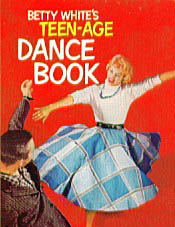
Teen Dances of the 1950s
Richard Powers

After the Swing Era and World War II, American social dancing cooled down in the late 1940s, in a shift from dance bands to concerts in night clubs. This
was due to many factors — musician union fees that made big bands unaffordable, the undanceable aesthetics of bebop cool jazz, and a generation of post-war
veterans with the new priority of settling down and raising a family.
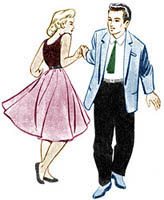
But teenagers still liked to dance. Teens' dancing during the 1950s was widely varied in steps and styling. Most
of it was still swing-based, but swing had been diverging into local styles and regional variations each decade for
thirty years. In one high school it might be low and smooth; in another, wild and angular. In some areas it was
constant swing moves, while in others it was dancing with steps in place, simply holding your partner's hand, with
no swing moves. Other innovations are listed below.
One incentive for new variations was the rebelliousness of the time — teens didn't want to dance like their parents
who were actively disapproving of their lifestyle, so they invented a wide range of step and style
replacements. Another motivation for change was the music. Rock'n'roll simply called for different styles of dancing,
some of which mirrored the strong backbeat of rock.
Terminology was just as varied as the dancing. This was called jitterbug, or swing, Lindy, the rock'n'roll,
boogie-woogie or Bop. The word Bop was new then, so almost everything was called the Bop. But that word usually referred to a family
of low swiveling Charleston-like steps danced in place, sometimes without a partner.
Some teens sought out African American sources for new steps and styles, sometimes from their black maids or from the
cooks at a summer camp, and especially from black teens at high school and local dances, which started to become possible
after a 1954 desegregation ruling.
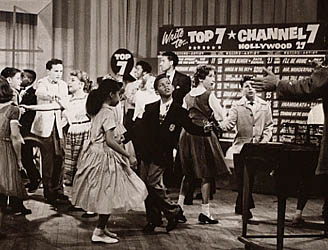 Another source of new dance styles was from television. Daily soap operas were finished by 3pm, and local stations needed
programming to fill the void until evening shows began. Since teenagers got home at that time, local stations
hired radio DJs to play popular teenage music as cameras televised teens dancing. One of the first was Bandstand on
Philadelphia's WFIL-TV (1952) hosted by former radio DJ Bob Horn. When he was fired after a drunk driving arrest in 1956,
Dick Clark was selected as his replacement.
Another source of new dance styles was from television. Daily soap operas were finished by 3pm, and local stations needed
programming to fill the void until evening shows began. Since teenagers got home at that time, local stations
hired radio DJs to play popular teenage music as cameras televised teens dancing. One of the first was Bandstand on
Philadelphia's WFIL-TV (1952) hosted by former radio DJ Bob Horn. When he was fired after a drunk driving arrest in 1956,
Dick Clark was selected as his replacement.
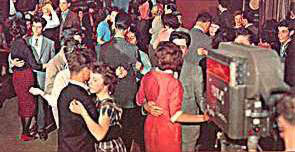 The increasingly wide regional diversification of dance styles reversed on August 5, 1957, when Clark convinced ABC
to broadcast his show nationally, becoming American Bandstand. Suddenly teens from coast to coast were seeing and
copying the way the kids in Philadelphia danced, and that regional style soon became a national dance style. Three
years later, the same thing would happen with the Twist, and from then on, teenagers got most their dances from television.
The increasingly wide regional diversification of dance styles reversed on August 5, 1957, when Clark convinced ABC
to broadcast his show nationally, becoming American Bandstand. Suddenly teens from coast to coast were seeing and
copying the way the kids in Philadelphia danced, and that regional style soon became a national dance style. Three
years later, the same thing would happen with the Twist, and from then on, teenagers got most their dances from television.
Other dances: In addition to the many styles of swing, there was also the Stroll, the solo version of Bop, Chalypso (American Bandstand's name for
teen cha-cha), the line dance Madison (soon followed by the Hully-Gully), the Bunny Hop, various kinds of slow dancing, and more.
The dance later known as the Twist was also done by teens in the mid-fifties, years before Chubby Checker made it a hit in
1960. (Watch the 1957 film Rock Baby Rock It for a good example.)
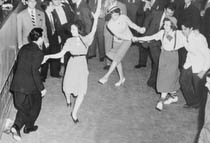
As a reference point, the most common style of swing at the beginning of the 1950s was:
Counts 1-2: Take a step, to walk through a swing move.
Counts 3-4: Take another step, to finish the swing move.
Count 5: Facing partner, rock back, in place.
Count 6: Replace weight forward, in place.
Timing is slow-slow-quick-quick, 6-count swing. Some began with the rock step.
With slower music, the two walking steps would be replaced by triple steps.
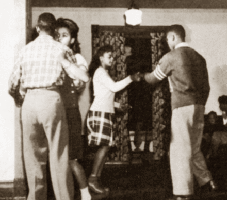
Changes made by teens in the 1950s:
Change 1) The walking steps were replaced by a tap-step, matching the strong backbeat of
rock music.
Change 2) Side-close-side triple steps were replaced by hook-replace-side
triples, with the strong side step emphasizing the backbeat.
Change 3) The tradition of executing one swing move after another was often replaced by mostly
dancing in place, holding one or both hands, with fewer swing moves.
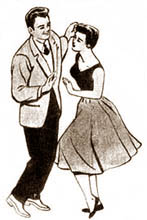 Change 4) Push off with one hand, drifting back away from partner on counts 1-4. Then
walk forward to your partner on counts 5-6. (Shown at left.) This replaced the rock step with walking forward.
Change 4) Push off with one hand, drifting back away from partner on counts 1-4. Then
walk forward to your partner on counts 5-6. (Shown at left.) This replaced the rock step with walking forward.
Change 5) Some teens danced in place on counts 1-4, then traveled forward through a
swing move on 5-6, or 4-5-6. This turned the figure inside-out — stationary where it used to travel, then traveling
where it used to rock-step in place.
1) Tap in place
2) Step to side
3) Tap 2nd foot in place
4-5-6) Walk forward through a swing move.
A fancier version, in triple-time, shown by several fifties teens:
1) Tap in place
2) Step to side, backing away from partner
3&4) Step back on 2nd foot, close back taking weight, step forward on the 2nd foot.
5-6) Continue walking forward 2 steps, through a swing move.
Note: The 1970s Latin Hustle is exactly this same step. The version above it became the American Hustle.
This also became Sugar Push in West Coast Swing. Today WCS dancers usually begin with the
above 5-6, with the Follow walking forward to him before the same 1950s push-off on the 1,2,3&4 above.
Change 6) While some rock and pop music continued the triple "swung" feeling of blues
and big band music, teenagers also danced to straight 4/4 music (similar to cha-cha rhythm) — an innovation from the 1950s
which continued into 1970s disco, and then West Coast Swing.
All six of these changes continued when 1950s teen swing became the Hustle during the 1970s. Some believe
that the Latin Hustle was created by Hispanics, from Cuban and Puerto Rican dances. But it was the 1950s rock'n'roll
teenagers who invented all of these changes. New York Latinos do deserve credit for keeping this teen swing tradition
alive from 1960 to the 1970s, while adding some of their own style, until it was reignited by the Disco scene.
All of these changes also continue today in West Coast Swing. Contrary to claims on some WCS web pages, 1950s
teenagers deserve the credit for many of the fundamental innovations that later defined West Coast Swing.
— Richard Powers